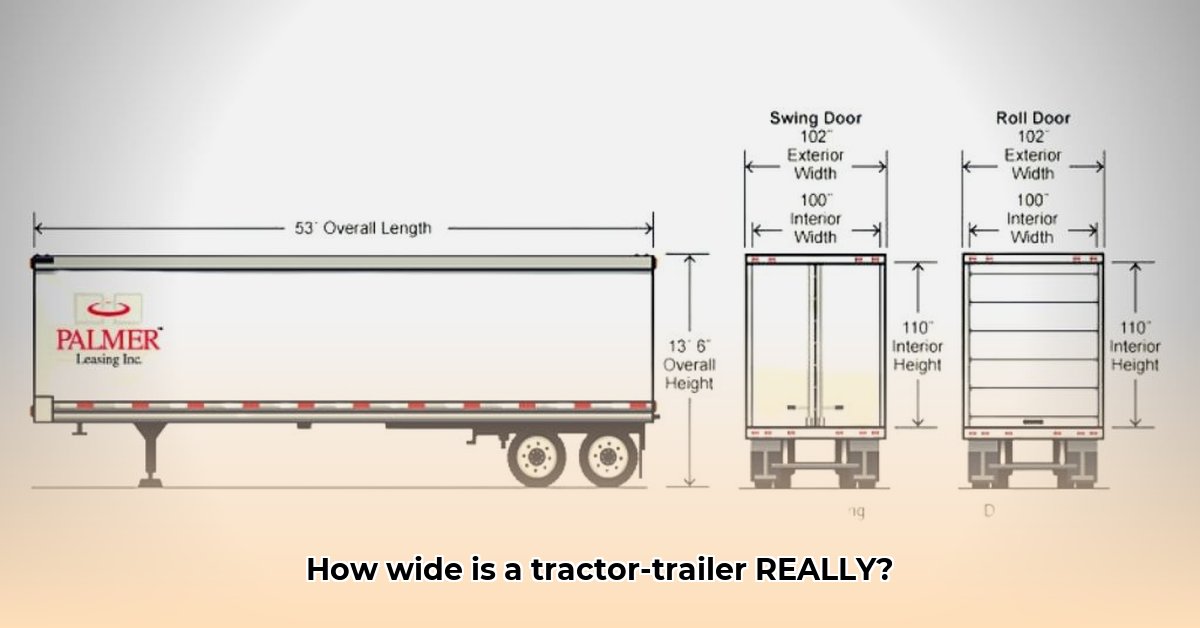
How Wide Is a Tractor Trailer Truck?
Ever wondered just how wide a semi-truck really is? It's more complex than you might think! The width isn't a fixed number; it depends on several interacting factors. Let's explore the key variables influencing the overall dimensions of a tractor-trailer combination. For more on truck dimensions, see this helpful guide on parking lot layouts.
The Typical Width: A Baseline Measurement
In most US states (49 to be exact), a standard dry van trailer (the common box-shaped trailer) measures 8.5 feet wide. This is a helpful starting point, but it represents only the trailer's width. Adding the tractor (the cab pulling the trailer) significantly increases the overall width. Numerous other factors will also add to this baseline.
Beyond the Basics: Sources of Width Variation
Several factors affect the exact width of a tractor-trailer. Understanding these nuances is vital for safe and legal operation:
Mirrors: Large side mirrors on the tractor unit add several inches to each side, often exceeding legal limits if you consider only the trailer width. While crucial for safety, they significantly impact overall dimensions.
Trailer Type: Different trailer types have vastly different widths. A flatbed (open trailer) may have a different width than a tanker (carrying liquids), and both may differ from a standard dry van. Specialized trailers for heavy equipment can be considerably wider still. The cargo itself often necessitates the type and therefore, the width, of the trailer.
State Regulations: While 8.5 feet is a common standard, state-specific regulations vary. Always confirm the regulations of the state(s) you'll be driving in to avoid fines or legal issues.
Safety Equipment: Added safety features such as side guards incrementally increase the total width. Although small, these features become significant when considering overall dimensions.
Why Width Matters: Legal Compliance and Safety
Understanding tractor-trailer width isn't trivial; it's crucial for safe and legal operation. Exceeding legal width limits results in fines, delays at checkpoints, and, most critically, significant safety hazards. Oversized trailers need special permits, requiring careful route planning and strict adherence to regulations.
Visualizing Width Differences
This table summarizes typical trailer widths:
| Trailer Type | Approximate Width (feet) | Notes |
|---|---|---|
| Standard Dry Van | 8.5 | Most common; forms the baseline width. |
| Flatbed | 8.5 - 10+ | Varies greatly depending on the secured load. |
| Tanker | 8.5 - 10+ | Often wider due to liquid tank shape. |
| Specialized Trailers | Varies greatly | Width entirely depends on the trailer's design. |
Obtaining Oversize Load Permits: A State-by-State Guide
The US lacks a unified system for oversize/overweight permits; each state sets its own regulations. While federal rules govern interstate highway weight limits, permit issuance remains a state-level responsibility. This means securing permits requires thorough planning and compliance.
Navigating the Permitting Process
Obtaining oversize load permits involves several key steps:
Measure Your Load: Accurately measure your load's length, width, and height, including any equipment.
Research State Regulations: Thoroughly research each state's regulations, noting limits, route restrictions, and escort vehicle requirements.
Submit Your Application: Most states offer online application portals. Complete these accurately, including documentation, dimensions, weight, and route maps.
Pay Fees: Permit fees vary significantly based on state and permit type (single trip versus annual).
Receive Your Permit: Upon approval, you'll receive your permit. Always carry a copy during your trip.
Factors Influencing Permitting
Numerous factors impact the permit process:
- Non-Divisible Loads: Demonstrating that your load cannot be divided into smaller units significantly impacts permit approval.
- Seasonal Restrictions: Seasonal weather conditions (hurricanes, etc.) often impose temporary bans or stricter regulations.
- Urban Area Restrictions: Navigating urban areas frequently mandates added approvals and meticulous route planning.
- Environmental Regulations: Some states impose stringent environmental impact rules, affecting route choice and permit requirements.
Key Takeaways: Navigating the Width Variability
- Tractor-trailer width varies significantly based on several interacting factors.
- State regulations differ considerably, mandating diligent research before transport.
- Oversize/overweight permits require adherence to a complex, state-by-state process.
- Accurate load measurements, thorough planning, and understanding of specific state rules are critical for legal and safe transportation. Ignoring these factors can lead to substantial fines and delays.